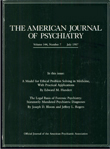Hazardous Benzodiazepine Regimens in the Elderly: Effects of Half-Life, Dosage, and Duration on Risk of Hip Fracture
Abstract
OBJECTIVE: While benzodiazepine treatment is known to increase the risk of hip fracture in older populations, controversy persists over which characteristics of benzodiazepine use (e.g., elimination half-life, dosage, duration of use) are most associated with such risks. METHOD: The authors reviewed the health care utilization data of 1,222 hip fracture patients and 4,888 comparison patients frequency matched on the basis of age and gender (all were at least 65 years old). Patients were enrolled in Medicare as well as in the New Jersey Medicaid or Pharmaceutical Assistance to the Aged and Disabled programs. Benzodiazepine use, as well as other covariates, were assessed before the index date (which was either the date of hospital admission for hip fracture surgical repair or, for the comparison subjects, a randomly assigned, frequency-matched date). RESULTS: All benzodiazepine doses ≥3 mg/day in diazepam equivalents significantly increased the adjusted risk of hip fracture by 50%. Significantly increased adjusted risks of hip fracture were seen during the initial 2 weeks of use (60% increase) and after more than 1 month of continuous use (80% increase) but not for 2–4 weeks of continuous use. Use of benzodiazepines other than long-acting agents significantly increased the risk of hip fracture by 50%. CONCLUSIONS: Even at modest doses, including some low doses currently advocated in prescribing guidelines for older patients, treatment with benzodiazepines appears to increase the risk of hip fracture. Patients appear to be particularly vulnerable immediately after initiating therapy and after more than 1 month of continuous use. Benzodiazepines with shorter half-lives appear to be no safer than longer half-life agents. Clinicians should be aware of these risks and weigh them against potential benefits when prescribing for elderly patients.



